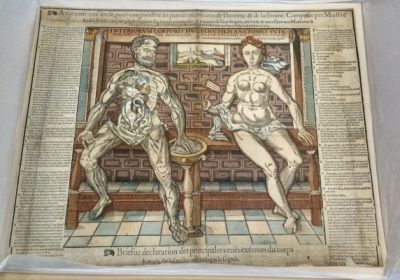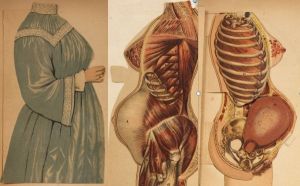Flap Anatomies - Women and Babies
Flap anatomies, also known as fugitive sheets in its earlier forms, are three dimensional renderings of human anatomy. By using a flap or series of flaps over an image, the artist is able to create a 3D experience, as the viewer can fold back layers to reveal hidden organs, tissues, and bones. Of interest is the use of flap anatomies to illustrate female anatomy and pregnancy. This taboo subject gained particular momentum in during the Renaissance, leading to an emergence of flap anatomies "prying open the secret of women." [1] These texts demonstrate a shift towards a medicalization of pregnancy as well as a fascination with female anatomy. [2]
Female Anatomy


While most flap anatomies concentrate on the male form and used men as the standard model, when female figures where used, the images almost always focus on her sexual parts. An early example of a fugitive sheet depicting the anatomy of a women is in Anatomie très utile: ‘The anatyme of the inwarde partis of man and woman’ (c.1559). In this image, as man and women sit next to eachother, each with flaps allowing a viewer to look inside. As a point of contrast, the many different organ systems appear under the male's flap, whereas only the urinary and reproductive system are shown under the woman's. The woman holds a sign that says,Nosce te ipsum. Knowe thyself, which is a reference to Reformation values of the time that emphasized verification through personal experience, which included exploring and understanding one's self. Along with this, Protestents and Lutherans of the time argued that faith was strengthened through appreciation of the human form, which might explain the shift of the religious publisher of the book from previously conservative books.[4] This image serves as an example of an emergence of permission to learn about female anatomy.
Lock and Key
Some flap anatomies, particularly those displaying the female body and discussing female sexuality, were considered obscene for the time and not appropriate for a wider audience. In the period of the late 1800s, a movement advocating for sex education and anatomical understanding was popularized. In alignment with this movement, books including detailed anatomical drawings of genital anatomy, such as M. Platen's Livre D'Or De Santeì (1909) and Physicians' Anatomical Aid (1880-1890), were published, but kept under lock and key until purchased. It is debated whether the lock was purely used to encourage interest in the books or as a way to deter unsuited readers, such as young boys. [5]
Pregnancy and Childbirth

With the advent of new printing technology, flap anatomies were able to publish in color and the flaps were able to lie flat when the book was closed.[7]One of the more famous uses of this new technology used to explore pregnancy was George Spratt's Obstetric Tables (1847). The book includes graphic images of women's genitals as well as detailed depictions of fetal development childbirth, including vaginal and cesarean delivery.[8] Spratt uses hand-colored lithograph images and uses up to four or five flap layers per image. Spratt was a member of the Royal College of Surgeons and practiced as a male mid-wife. The intended use of the book was as teaching aid to fellow practitioners.

A new audience later emerged in the 20th century for these flap anatomies in the form of "home health manuals." One example is seen in Myer Solis-Cohen's Woman in girlhood, wifehood, motherhood (1906). This book served to guide women on their responsibilities as well as inform women on health management for women and children. In this genre, there is a notable shift toward a more modest dress, with little skin showing in the top flap. [10]
References
- ↑ “Anatomy.” Duke University Libraries , exhibits.library.duke.edu/exhibits/show/anatomy/anatomy/intro
- ↑ “Anatomy.” Duke University Libraries , exhibits.library.duke.edu/exhibits/show/anatomy/anatomy/intro
- ↑ "Anatomie très utile: ‘The anatyme of the inwarde partis of man and woman’"Hogan, C. (2017, March 24). Anatomie très utile: ‘The anatyme of the inwarde partis of man and woman’. Retrieved November 25, 2020, from https://www.rcseng.ac.uk/library-and-publications/library/blog/anatomie-tres-utile/?_id=3DC43A20F2974FC1BB088255235DA24E&_z=z
- ↑ "Anatomie très utile: ‘The anatyme of the inwarde partis of man and woman’"Hogan, C. (2017, March 24). Anatomie très utile: ‘The anatyme of the inwarde partis of man and woman’. Retrieved November 25, 2020, from https://www.rcseng.ac.uk/library-and-publications/library/blog/anatomie-tres-utile/?_id=3DC43A20F2974FC1BB088255235DA24E&_z=z
- ↑ “Anatomy.” Duke University Libraries , exhibits.library.duke.edu/exhibits/show/anatomy/anatomy/intro
- ↑ "Under your skin anatomical flap books" Isaac, S. (2019, October 25). Under your skin anatomical flap books. Retrieved November 25, 2020, from https://www.rcseng.ac.uk/library-and-publications/library/blog/under-your-skin-anatomical-flap-books/
- ↑ "Spratt's "Obstetric Tables"" Mellby, J. L. (2019, March 25). Spratt's "Obstetric Tables". Retrieved November 25, 2020, from https://www.princeton.edu/~graphicarts/2010/03/spratts_obstetric_tables.html
- ↑ “Anatomy.” Duke University Libraries , exhibits.library.duke.edu/exhibits/show/anatomy/anatomy/intro
- ↑ "Under your skin anatomical flap books" Isaac, S. (2019, October 25). Under your skin anatomical flap books. Retrieved November 25, 2020, from https://www.rcseng.ac.uk/library-and-publications/library/blog/under-your-skin-anatomical-flap-books/
- ↑ "Under your skin anatomical flap books" Isaac, S. (2019, October 25). Under your skin anatomical flap books. Retrieved November 25, 2020, from https://www.rcseng.ac.uk/library-and-publications/library/blog/under-your-skin-anatomical-flap-books/